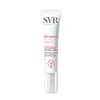What's inside
What's inside
 Key Ingredients
Key Ingredients

No key ingredients
 Benefits
Benefits

 Concerns
Concerns

 Ingredients Side-by-side
Ingredients Side-by-side

Water
Skin ConditioningGlycerin
HumectantCaprylic/Capric Triglyceride
MaskingButylene Glycol
HumectantPolysorbate 60
EmulsifyingGlyceryl Stearate
EmollientButyrospermum Parkii Butter
Skin ConditioningBeeswax
Emulsion StabilisingPEG-100 Stearate
10-Hydroxydecenoic Acid
Skin ConditioningCaprylyl Glycol
EmollientCetyl Alcohol
EmollientCitric Acid
BufferingGlycyrrhetinic Acid
Skin ConditioningPolyacrylate-13
Polyisobutene
Polysorbate 20
EmulsifyingSclerotium Gum
Emulsion StabilisingSorbitan Isostearate
EmulsifyingWater, Glycerin, Caprylic/Capric Triglyceride, Butylene Glycol, Polysorbate 60, Glyceryl Stearate, Butyrospermum Parkii Butter, Beeswax, PEG-100 Stearate, 10-Hydroxydecenoic Acid, Caprylyl Glycol, Cetyl Alcohol, Citric Acid, Glycyrrhetinic Acid, Polyacrylate-13, Polyisobutene, Polysorbate 20, Sclerotium Gum, Sorbitan Isostearate
Water
Skin ConditioningPropanediol
SolventHydrogenated Polydecene
EmollientCyclopentasiloxane
EmollientOrbignya Oleifera Seed Oil
EmollientPolyacrylamide
Behenyl Alcohol
EmollientCaprylic/Capric Triglyceride
MaskingDipotassium Glycyrrhizate
HumectantSaccharide Isomerate
HumectantSodium Hyaluronate
HumectantTocopheryl Acetate
Antioxidant1,2-Hexanediol
Skin ConditioningC13-14 Isoparaffin
EmollientCaprylyl Glycol
EmollientCeteareth-20
CleansingCitric Acid
BufferingGossypium Herbaceum Seed Oil
Skin ConditioningLaureth-7
EmulsifyingPentylene Glycol
Skin ConditioningSodium Citrate
BufferingSodium Polyacrylate Starch
AbsorbentWater, Propanediol, Hydrogenated Polydecene, Cyclopentasiloxane, Orbignya Oleifera Seed Oil, Polyacrylamide, Behenyl Alcohol, Caprylic/Capric Triglyceride, Dipotassium Glycyrrhizate, Saccharide Isomerate, Sodium Hyaluronate, Tocopheryl Acetate, 1,2-Hexanediol, C13-14 Isoparaffin, Caprylyl Glycol, Ceteareth-20, Citric Acid, Gossypium Herbaceum Seed Oil, Laureth-7, Pentylene Glycol, Sodium Citrate, Sodium Polyacrylate Starch
 Reviews
Reviews

Ingredients Explained
These ingredients are found in both products.
Ingredients higher up in an ingredient list are typically present in a larger amount.
This ingredient is an emollient, solvent, and texture enhancer. It is considered a skin-softener by helping the skin prevent moisture loss.
It helps thicken a product's formula and makes it easier to spread by dissolving clumping compounds.
Caprylic Triglyceride is made by combining glycerin with coconut oil, forming a clear liquid.
While there is an assumption Caprylic Triglyceride can clog pores due to it being derived from coconut oil, there is no research supporting this.
Learn more about Caprylic/Capric TriglycerideCaprylyl Glycol is a humectant and emollient, meaning it attracts and preserves moisture.
It is a common ingredient in many products, especially those designed to hydrate skin. The primary benefits are retaining moisture, skin softening, and promoting a healthy skin barrier.
Though Caprylyl Glycol is an alcohol derived from fatty acids, it is not the kind that can dry out skin.
This ingredient is also used as a preservative to extend the life of products. It has slight antimicrobial properties.
Learn more about Caprylyl GlycolCitric Acid is an alpha hydroxy acid (AHA) naturally found in citrus fruits like oranges, lemons, and limes.
Like other AHAs, citric acid can exfoliate skin by breaking down the bonds that hold dead skin cells together. This helps reveal smoother and brighter skin underneath.
However, this exfoliating effect only happens at high concentrations (20%) which can be hard to find in cosmetic products.
Due to this, citric acid is usually included in small amounts as a pH adjuster. This helps keep products slightly more acidic and compatible with skin's natural pH.
In skincare formulas, citric acid can:
While it can provide some skin benefits, research shows lactic acid and glycolic acid are generally more effective and less irritating exfoliants.
Most citric acid used in skincare today is made by fermenting sugars (usually from molasses). This synthetic version is identical to the natural citrus form but easier to stabilize and use in formulations.
Read more about some other popular AHA's here:
Learn more about Citric AcidWater. It's the most common cosmetic ingredient of all. You'll usually see it at the top of ingredient lists, meaning that it makes up the largest part of the product.
So why is it so popular? Water most often acts as a solvent - this means that it helps dissolve other ingredients into the formulation.
You'll also recognize water as that liquid we all need to stay alive. If you see this, drink a glass of water. Stay hydrated!
Learn more about Water